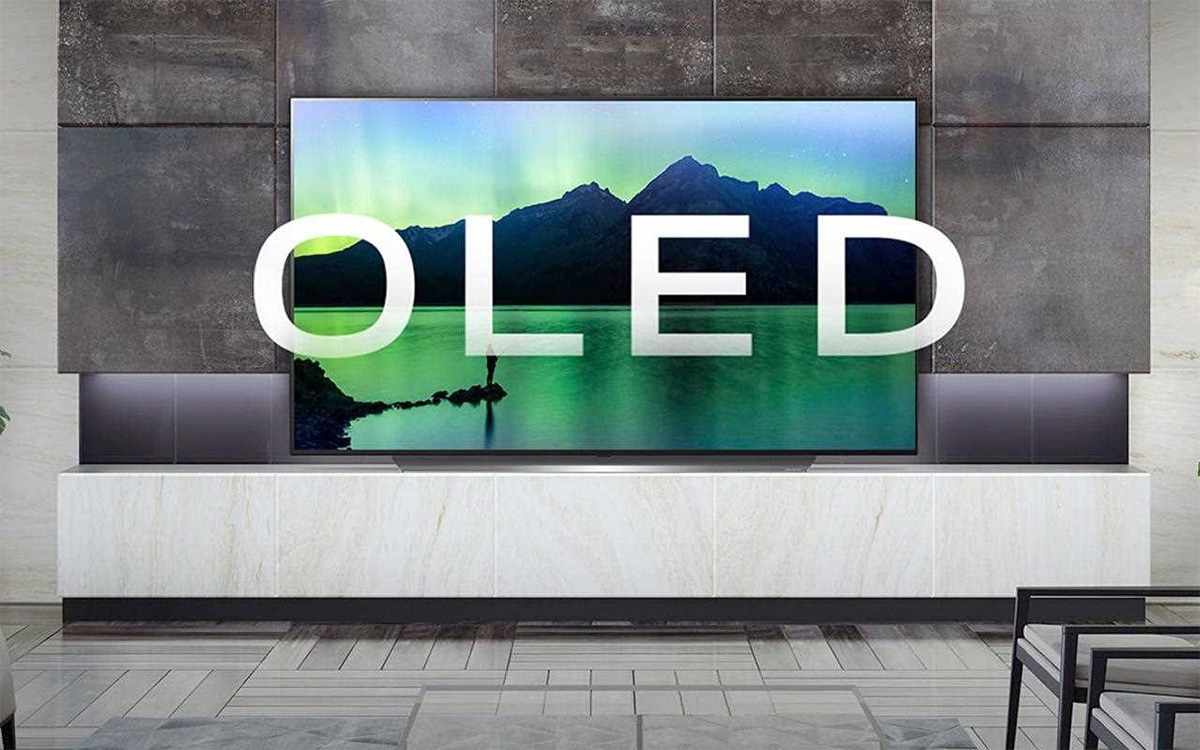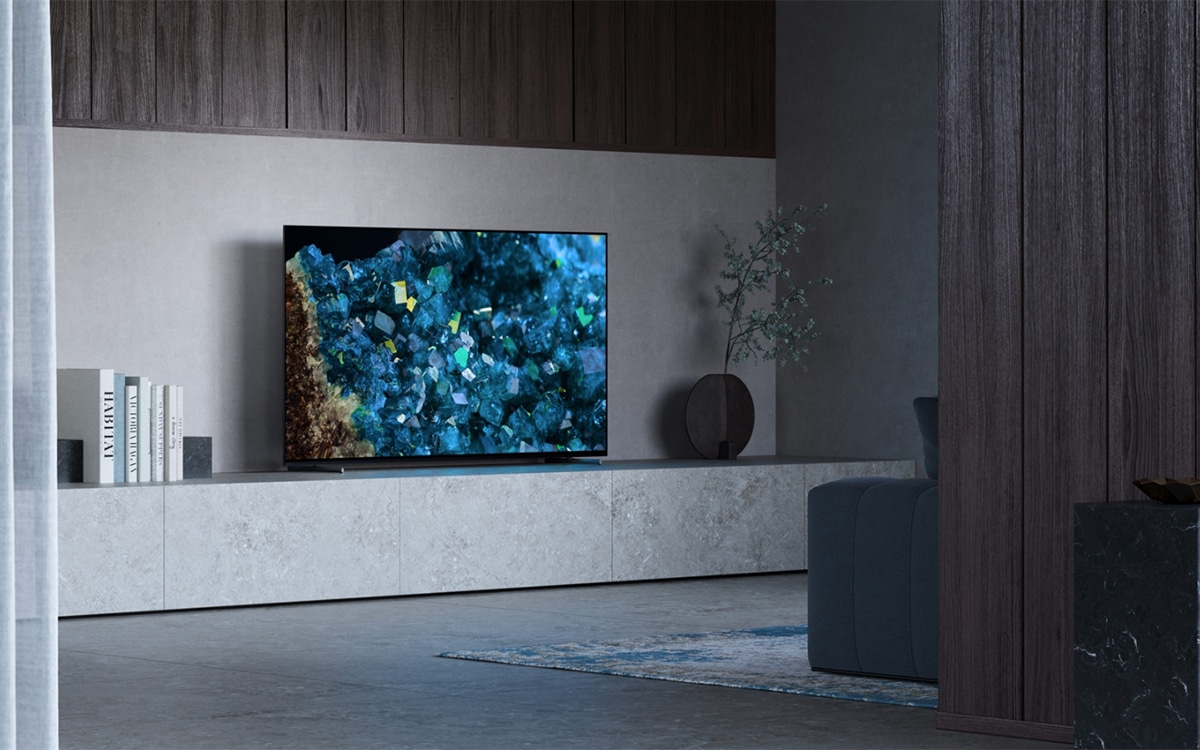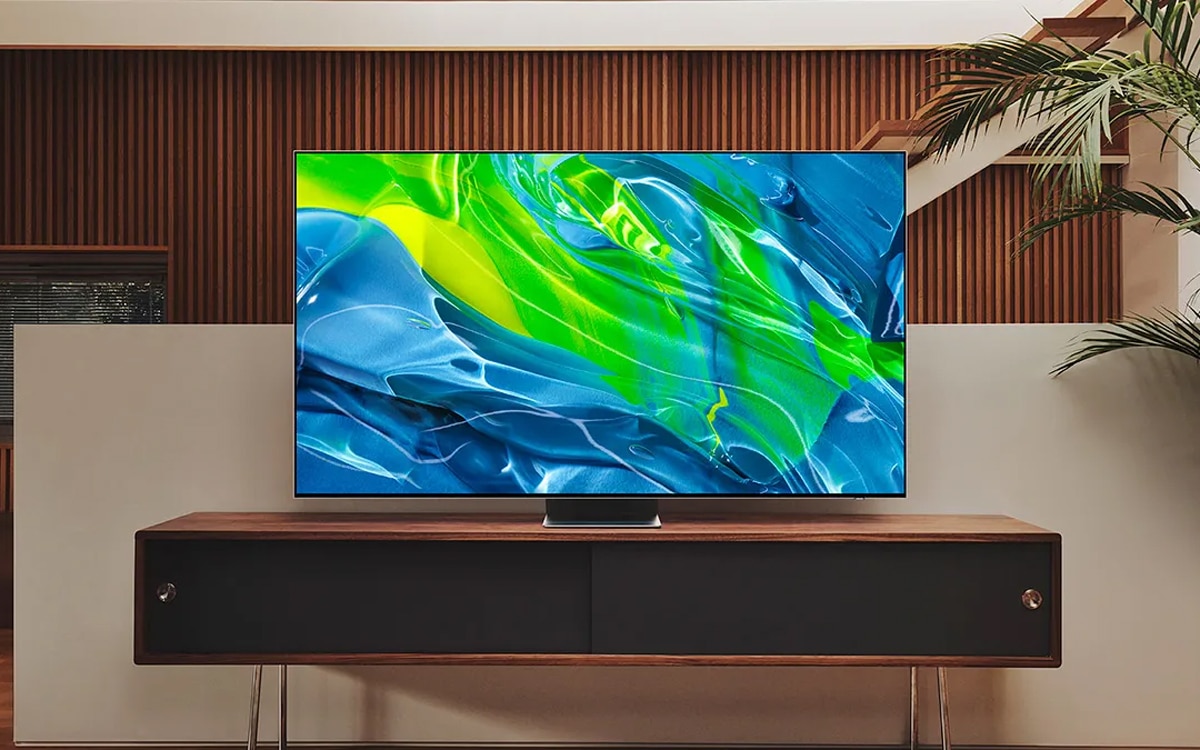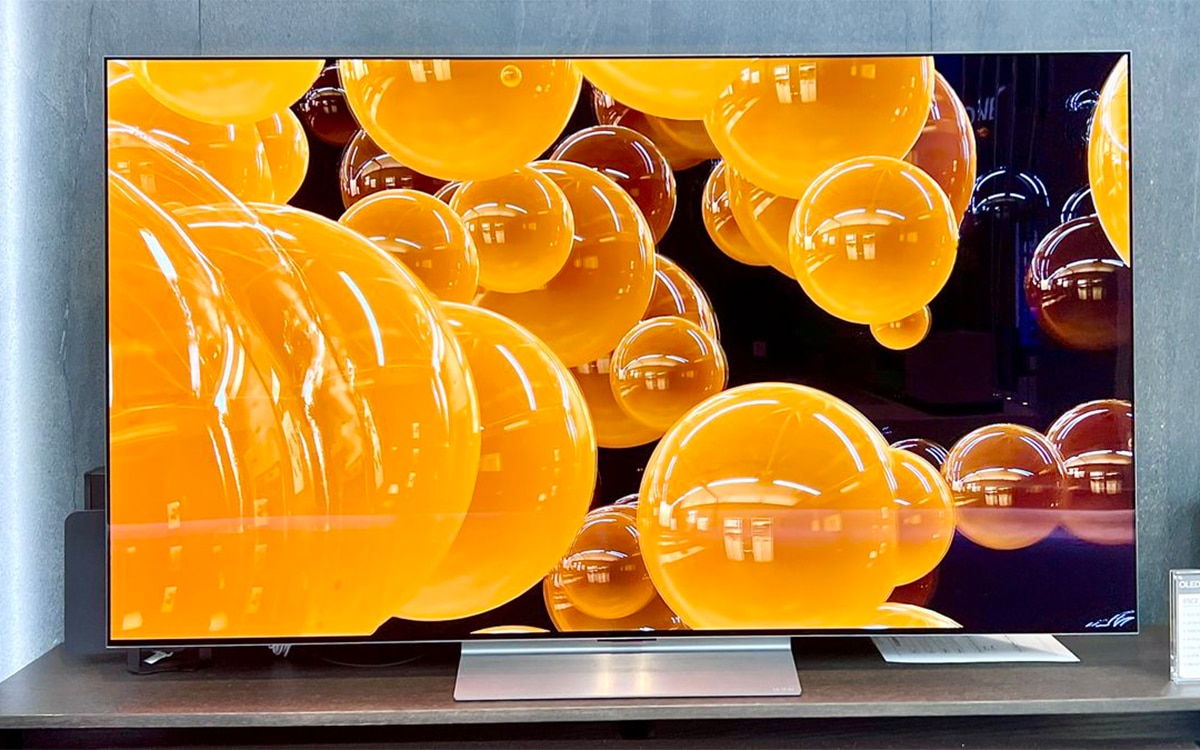However, another way that TVs distinguish them is in terms of their display technologies. Taking a look through some of the various TVs on the market, you’d quickly be inundated with terms like “OLED”, “QLED”, and “LED”. But to the layperson, these terms can often be a little confusing.
Many people often find themselves wondering what makes OLED TVs so special. Especially in terms of how they differ from standard LED TVs. If you’re looking to learn a little more about OLED displays, then this is the definitive guide you’ve been searching for! Our Reliant tech experts have lent us their years of OLED TV knowledge, to help you learn a little more about this unique display type!
What Is OLED?
Naturally, it would be wise to start with the simplest question of all. What exactly is OLED?
The term “OLED” is actually an abbreviation of “Organic Light-Emitting Diode”. An OLED TV display is made up of millions of these individual diodes, which you might often hear referred to as “Pixels”. These diodes are responsible for creating the images that are then displayed on your TV screen. As well as that, however, these diodes also produce their own light. This means that there’s no need for a backlight in an OLED TV! In turn, this means that OLED TVs are often designed to be immensely slim.
OLED refers to “Organic Light-Emitting Diode”. Millions of these are packed into a single OLED display, to create images. These can not only be used to recreate images but also produce their own light!
OLED TVs are incredibly quick and responsive and result in some incredibly sharp imagery. This is thanks to the fact that the pixels provide their own light. Where needed, the pixels can turn off completely. Thanks to this, OLED displays are able to recreate true black values. This is great for moody horror movies and games, allowing for the perfect sense of atmosphere. True black values also result in much greater contrast. Juxtaposed against the black values, colours also appear all the more vibrant. This makes it much easier to keep up with all the action.
How Does OLED Differ From Other Display Technologies?
Now that we’ve got a firm grasp on what OLED actually is, you might find yourself wondering how OLED differs from other display types. There is a clear difference between QNED, QLED and OLED TVs.
The main characteristic that differentiates OLED TVs from other display types is how light is produced. As we mentioned above, each pixel on an OLED display can produce its own light. Other display types, like LED and QLED, make use of distinct backlight arrays. The pixels on these displays produce an image, and then the backlight shines light through the pixels. This allows the on-screen image to be visible!
The lack of a backlight means that OLED TVs can be manufactured to be incredibly thin. This makes them great for homes that are short on available space in the living room! It also means that OLED displays can produce images with greater contrast. We wrote earlier that OLED displays can recreate true black values. This sets them completely apart from other display types. QLED and LED displays often have trouble creating black values. This is because light from the backlights naturally bleeds through the black pixels. Resulting in a dull grey!
What’s The Difference Between OLED And QLED?
If you’ve ever found yourself unsure what the practical difference between these two display types is, don’t worry! Though they may sound very similar, they’re actually very different.
OLED and QLED are two very distinct display technologies. QLED TVs make use of microscopic quantum dots, capable of producing highly accurate colour. OLED TVs instead use self-illuminating pixels. This means they don’t need a backlight!
What makes QLED displays unique is their use of quantum dot technology. Quantum dots themselves are actually microscopically small semiconductors that can produce light of specific colours. QLED TVs are capable of producing highly specific colours, which gives them great richness and clarity. These colours are then projected through the use of backlights.
While QLED TVs are decidedly more colourful than OLED TVs, they lack slightly in terms of contrast!
Are There Other Types Of OLED Displays?
Yes! There are actually a few distinct OLED subtypes that actually combine the benefits of OLED displays with the benefits of other display types!
One of these is the “QD OLED”. QD OLEDs combine the benefits of OLED displays and QLED displays. Usually, a QD OLED TV takes the form of a standard OLED TV, with a quantum dot layer added just ahead of the OLED layer.
There are a number of benefits to QD OLED TVs. One is that these displays are able to offer the rich colours found in standard QLED TVs. As well as this, QD OLED TVs also offer higher brightness levels than standard OLED TVs. At the same time, the OLED layer is still able to provide true black values.
However, QD OLED TVs are not easy to find, and they often cost quite a lot more. This can make them quite an impractical option for many people!
Are OLED TVs Worth Buying?
Absolutely. OLED TVs have become immensely popular across the world, thanks to the many benefits they offer. OLED displays are also highly affordable, and perfectly compatible with higher resolutions and larger screen sizes. Let’s take a look at some of the distinct benefits of these displays!
What Are The Benefits Of OLED TVs?
Improved Contrast
It cannot possibly be overstated just how important the improved contrast of an OLED display is. Each individual pixel in an OLED display can turn on and off as needed. This means that these screens are capable of creating true black values. Of course, this results in greater contrast, as colours appear much richer in comparison.
When paired with an HDR video source, OLED displays are totally unrivalled. HDR is a special video format that enhances the range of colours and brightness levels that a TV can use to display an image. This results in a much more colourful image with greater clarity.
They’re Incredibly Thin
We’ve noted before that the lack of a backlight allows OLED TVs to be incredibly thin. This not only makes them easy to situate in your living room. It also means that they have an incredibly modern look.
OLED TVs are perfect for those who want a modern and minimalist look to their living room. OLED TVs lack a backlight, and thus they can be manufactured to be incredibly slim.
Despite their skinny form factors, these TVs are still often able to boast immense sound capabilities. So not only does your content look amazing, but it also sounds amazing!
OLED TVs Are Easy To Watch
One of the biggest drawbacks of standard LED TVs is their limited viewing angles. If you sit at too sharp of an angle from one of these TVs, you’ll find that the image appears dull. This is because the backlights can only project lights in highly specific directions.
OLED TVs, on the other hand, don’t have this issue. They can be viewed at just about any angle, and you’ll still receive a perfect image. This is because it’s much easier for the OLED pixels to project light at wider angles.
If you want to have a group of friends around to watch the latest football match, or the season finale to that hit show, then an OLED TV is highly beneficial. Everyone will feel like they have the best seat in the house!
They’ll Save You Money!
OLED TVs actually consume a lot less electricity than other competing TV types. Again, this comes down to the fact that these displays aren’t backlit. LED and QLED backlights can consume a lot of electricity in order to produce their high brightness levels.
Of course, how much energy an OLED TV consumes depends on the type of content and the brightness of the screen. HDR and 4K content will naturally require more energy. As well as this, if you have the brightness cranked up all the way, an OLED TV will also consume more energy.
OLED TVs are great for energy-conscious TV lovers. These displays naturally use much less electricity thanks to the omission of a backlight. These TVs also often come with built-in eco-modes for improved efficiency.
An OLED TV can be a great way to reduce your energy bills little by little. Just be sure to keep the brightness down. Your eyes will thank you!
They’re Incredibly Responsive
OLED pixels are responsible for generating images and producing light. This means that they’re designed to be immensely responsive and fast-acting. Interacting with an OLED TV almost feels like second nature.
In turn, this also means that they’re perfect for gaming. Gamers require incredibly responsive displays that react to their inputs in mere milliseconds. OLED TVs are perfect for facilitating this. These displays often have response times as short as 0.2 milliseconds. This puts them well ahead of the competition for gamers. QLED and LED displays on the other hand often have much higher latency. Taking entire milliseconds to respond.
To non-gamers, this really can seem like splitting hairs. But the difference in feel from extra milliseconds can totally ruin the gameplay experience!
OLED Displays Are Great At Higher Resolutions
OLED displays are perfect for those who want higher resolutions in their homes. If you’re looking for a 4K TV or even an 8K TV, then an OLED display is a great call.
OLED displays are perfect for fans of high-definition film and TV. These displays are perfectly suited to displaying 4K and 8K imagery. The self-illuminating pixels allow for perfect contrast to let HDR images shine.
OLED displays allow for much sharper imagery, especially when used to display HDR images. 4K HDR images on an OLED display nearly pop from the screen thanks to the sheer density of detail.

What Are The Potential Drawbacks Of OLED TVS?
OLED TVs offer a number of benefits for TV users of all kinds. From film lovers to gamers, there’s something to love about OLED displays. However, as beneficial as they are, there are a few potential drawbacks to be wary of!
OLED TVs Aren’t As Bright
Compared to other display types, OLED TVs are not quite as bright. For many, this might not be too much of a problem. However, for some, it might be a dealbreaker. QLED and LED TVs can easily achieve double the brightness levels of an OLED TV. This makes them perfect for brighter rooms.
OLED TVs can sometimes be a little difficult to see in the brightest of rooms. Especially during the sunniest days. Sunlight shining directly onto an OLED display can render the screen totally useless. No matter how much you crank up the brightness!
They Aren’t As Colourful
We mentioned above that quantum dot technology allows a TV to access a much wider array of colours. This means that QLED displays are naturally much more colourful than OLED displays. For film fans, the extra colour depth of a QLED display might be a little more attractive. Images on QLED displays can often appear much more lifelike and vibrant.
However, when OLED TVs are used to display HDR images, they can achieve a much wider range of colours for greater immersion!
They’re Susceptible To Screen Burn-In!
Screen burn-in is an issue that can occur to TVs of all types. It refers to a situation in which a static image quite literally becomes burned in on the screen of a TV. This can be incredibly annoying in severe cases, as the burned image can distract from any footage playing on-screen!
Unfortunately, OLED TVs are most susceptible to screen burn-in. The reason for this is because of how they operate. As we mentioned earlier, the image on an OLED screen is made by each of the millions of pixels producing light of specific colours. Much like standard LED backlights, eventually these pixels can burn out, if subjected to too much power. For instance, if an OLED TV were left paused on a bright image, then the brightest areas of the image would be putting the largest strain on the pixels. When these pixels burn out, their ability to push out light is dampened!
OLED TVs are the most susceptible to screen burn-in of all display types. Luckily, modern OLED TVs are often manufactured specifically to prevent the issue from occurring. Now, screen burn-in is actually relatively rare.
Screen burn-in most often happens when TVs are accidentally left on. However, it can also happen in smaller cases. Such as when static elements are left on-screen for too long. For instance, channel logos that stick to the corners of the screen can end up causing screen burn-in!
If this is your first time hearing about screen burn-in, it might sound pretty frightening. Luckily, many modern OLED TVs are now designed to counteract the issue. We’ll explore screen burn-in in a little more detail shortly!
They’re Expensive To Fix
Following on from the above, it must be noted that OLED TVs are costly to repair. Unfortunately, screen burn-in is an issue that cannot simply be fixed without totally replacing the screen itself. This is because the process of manufacturing an OLED TV is considerably difficult. In the early days of OLED TVs, their high prices easily reflected their delicate nature.
Screen Burn-in is, however, much less frequent than it used to be. Early OLED TVs were highly susceptible to screen burn-in, but in the years since, they’ve become less so. Manufacturers understand the various concerns that surround screen burn-in, and thus they’ve included many technologies that help to prevent it. We’ll take a closer look at some of these further on!
They’re Fragile
When finding the perfect spot for an OLED TV, you’ll need to make sure it’s firmly in position. This is because OLED TVs are immensely fragile. The slightest bump or fall could result in costly repairs or the need for an outright replacement!
OLED TVs are quite fragile. They’re much thinner and thus much more delicate than many other display types. Be sure to store one safely and efficiently to spare yourself any repair costs!
If you live in a busy household, with plenty of younger children, then an OLED TV may be put at a slightly higher risk of damage.

Are OLED TVs Good For Gaming?
When it comes to choosing the perfect TV, avid gamers generally have a very different set of characteristics that they look out for!
Luckily, OLED TVs tick a number of boxes that are highly important to gamers across the world. Most importantly, OLED displays are immensely responsive. OLED displays have some of the lowest levels of input lag on the market. Especially when compared to QLED and LED displays. This means that there’s next to no time between pressing a button on a game controller, and seeing the corresponding action play out on screen! This can actually make gamers perform better, as they’ll feel totally in tune with their in-game avatars!
We’ve mentioned a few times that OLED screens can replicate high-contrast images. This is not only beneficial for films and TV shows. With greater image contrast, it becomes much easier to stay ahead of the action in even the most explosive of titles. You’ll be able to notice every single detail on the screen!
Gamers can benefit a lot from OLED displays, especially when it comes to smooth control! Just make sure to keep in mind that OLED displays can be at risk of screen burn-in. Even when gaming.
What Should You Look For In An OLED TV?
Now that we’ve spent some time looking into what makes OLED TVs unique, you’re likely feeling ready to grab one of your own! But how do you choose the right OLED TV? Especially when you consider just how many models there are! Below, we’re going to take a look at some of the most important features to look out for in any OLED TV.
Screen Size
Why beat around the bush? This is likely one of the first things you’d look into when in the market for a new TV. The display technology used in OLED TVs lends itself perfectly to screens of all sizes! Whether you’re looking for a huge screen or a smaller screen for a bedroom.
Having an idea of your intended screen size helps to vastly narrow down your options, so you can more easily pick that one perfect OLED TV. But don’t simply go for the largest screen just because you can. You need to choose screen size sensibly. You don’t want a screen that’s too large!
Resolution
If you’re going for a larger TV screen, be sure to pair it with a higher resolution. Screen resolution and size go hand in hand, and both need to be carefully considered. If you were to opt for an 85-inch TV, for instance, we would recommend at least a 4K resolution. A lower-resolution image spread across a screen of this size would appear pixelated and stretched out!
OLED displays naturally look amazing. You can make one look even more amazing by choosing a high resolution. Be sure to pair a high resolution with a large screen size. This will all ensure a cinematic viewing experience!
To make the most of the image benefits of an OLED display, you’ll want to make sure you get a TV with a great resolution.
HDR Support
OLED displays are some of the most detailed on the market. Images simply appear much more crisp and far more pleasant. This can be made even more so with compatibility for HDR video formats.
HDR is a video format that allows your TV to access different brightness levels and colours. These new colours can more easily be shown off on an OLED display, thanks to the enhanced contrast.
Screen Burn-In Countermeasures
In the years since OLED TVs were first introduced, manufacturers have had plenty of time to devise ingenious ways to counteract the issue. Be sure to look out for these countermeasures.
High Refresh Rates
If you’re planning to use a new OLED TV as a gaming display, you’ll want to keep an eye out for higher refresh rates. With a higher refresh rate, your games will run more smoothly. For instance, a 120Hz display is able to refresh its image 120 times per second! This is essential for gaming on modern consoles like the PlayStation 5 and Xbox Series X, which can output at speedy 120FPS rates!
Are OLED TVs More Susceptible To Screen Burn-In?
Unfortunately, OLED TVs are more susceptible to screen burn-in, simply thanks to how they operate. However, manufacturers are aware of this heightened risk and have installed many countermeasures in their models to ensure the issue is prevented.
OLED TVs are much more likely to encounter screen burn-in if they have high brightness levels. As such, it’s recommended to keep the brightness levels down wherever you can!
Once an OLED TV has suffered from screen burn-in, it’s impossible to reverse it. As such, you’ll want to be sure to take care of an OLED TV while you have it!
There are quite a few things that can be done to prevent screen burn-in from occurring. Let’s take a look at some of these!
How Can You Prevent Screen Burn-In On An OLED TV?
Reduce Screen Brightness
One of the easiest and most effective ways to keep an OLED display from burning out is to lower its brightness! Screen burn-in occurs most frequently as a direct result of high brightness. When pixels are responsible for maintaining high levels of brightness for long periods, they’re more likely to burn out.
One of the best ways to prevent screen burn-in is to lower your screen’s brightness. High brightness levels put a significant strain on OLED pixels. This can increase the rate at which they burn out!
We’re not suggesting that you lower the brightness so much that you can’t see anything! Instead, simply lower the brightness a few increments lower than you normally have it. This might seem like an insignificant gesture in the short term, but it can lengthen the lifespan of an OLED TV by entire hours!
Turn Your TV Off!
We would never suggest that you don’t turn your TV on ever again! That would be totally crazy! Instead, we simply recommend that you turn the TV off whenever it’s not in use.
Many cases of screen burn-in occur accidentally because the user has unknowingly left the screen on. If you’ve ever stepped up from the sofa to carry out a small errand, only to find yourself returning hours later, with the TV still on, you’ll know how easily this can happen!
Whenever you need to step away from your TV for any amount of time, make a habit of turning it off. Your TV shows will still be there waiting for you when you return. This helps to prevent accidentally leaving the TV on!
Use A Sleep Timer
To help prevent screen burn-in, many OLED TVs come with automatic sleep timers built in. These are programmed to forcibly switch off your TV’s display after a certain amount of inactivity. If you are at all prone to leaving your TV on, then you should make sure to make good use of this!
Sleep timers can be fine-tuned to your specific needs. You can set it to kick in after 30-minutes, or after 2-hours. Whatever time works for you.
Ultimately, this simple technology helps to prevent you from accidentally leaving your OLED TV on! No more worries about accidental screen burn-in!
Use Pixel Shift
Many OLED TVs are now fitted with pixel shift technology, which is specifically designed to protect against screen burn-in. Essentially, this technology shifts pixels around, while the TV is in use. This prevents specific pixels from being overburdened with holding up a specific image for too long.
Pixel shift is totally worth using to prevent screen burn-in. By shifting the pixels around, you lessen the burden placed on them by specific images. This helps to prevent screen burn-in completely!
This might sound like quite a drastic procedure. Surely you’d notice the pixels shifting when it happens and get drawn out of the action, right? Luckily, pixel shift is actually a very subtle technology. You’d be very unlikely to notice it when watching your favourite films or lost in the action of your favourite games.
Pixel shift is especially essential for gamers. It helps to prevent static in-game elements from burning into the display. By this, we mean elements like health bars and mini-maps, which tend to remain firmly fixed on the screen during play!

Frequently Asked Questions
What Is OLED?
OLED is a specialised display format that makes use of millions of self-illuminating pixels. Unlike other display types, OLED negates the need for any kind of backlight. This is because OLED pixels not only display images but produce their own light. This means that OLED TVs consume much less electricity, and can actually be built to be much slimmer. They’re great for modern homes!
Is OLED Better Than 4K?
No. OLED and 4K are actually very different things. OLED refers to a specific TV display type. 4K, instead refers to a specific TV resolution. OLED displays and 4K resolutions do go really well together, though! OLED displays are incredibly crisp and have great contrast. They’re fantastic for showing off the benefits of 4K!






0 Comments